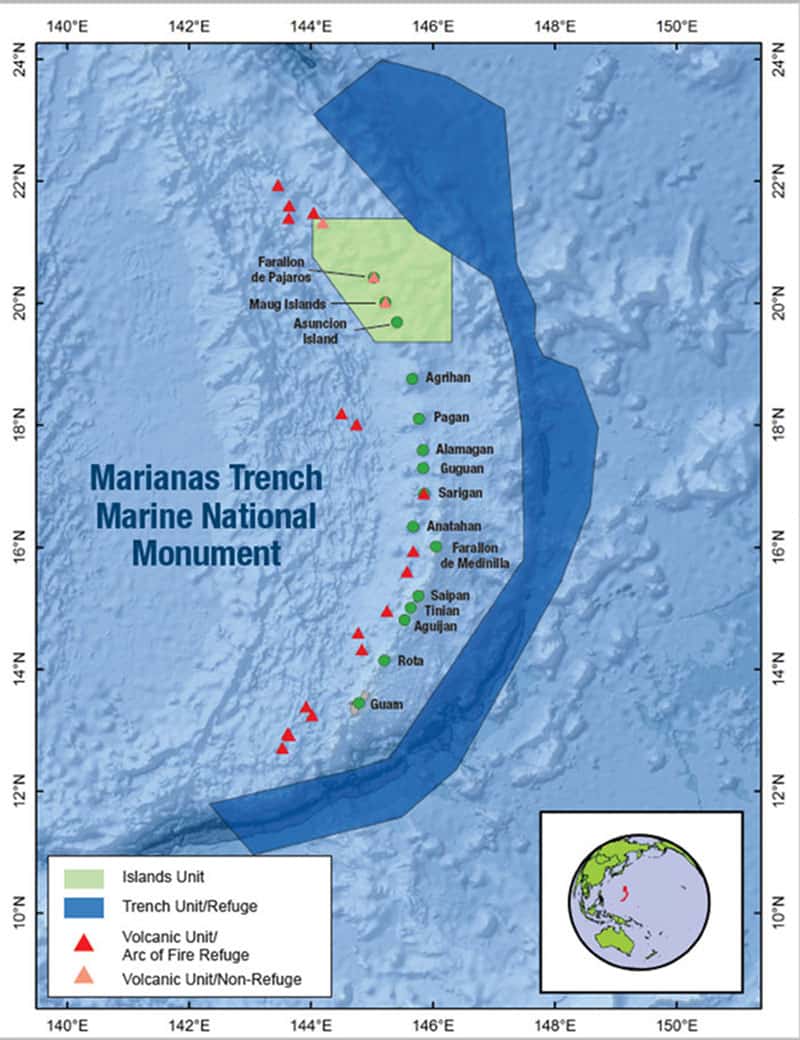The Pacific Ocean is one of the world’s five oceans.
The ocean got its name from Portuguese Explorer, Ferdinand Magellan. Magellan experienced favorable winds upon reaching the ocean, naming it “Mar Pacifico,” which means “peaceful sea” in Portuguese.
Learn some geography facts about this ocean.

World’s Largest Ocean
With an area of 165,250,000 square kilometers (63,800,000 square miles), the Pacific Ocean is the world’s largest ocean.
The Pacific Ocean makes up about 28% of the Earth’s surface area and represents 46% of the water surface area. The area of the Pacific Ocean is larger than the total area of all of the world’s land masses.

Half of the World’s Free Water
The Pacific Ocean is by far the world’s largest ocean basin. It contains half of the world’s free water.
World’s Deepest Ocean
The Pacific Ocean is also the world’s deepest ocean.
The western Pacific Ocean is transected by deep trench.

Among these trenches is the Mariana Trench where Challenger Deep, the deepest point in the world with a depth of 10,984 meters (36,037 feet). The Marianas Trench Marine National Monument was established in January 2009 through a presidential proclamation under the authority of the Antiquities Act of 1906.
You can experience an armchair geographer’s view with this fascinating animation created by NOAA of a diving into the Marianna Trench: An Animated Dive Through of the World’s Deepest PointPlay Video
The average depth of the Pacific Ocean is 4,000 meters (13,000 feet).
The Pacific Ocean is Shrinking
As a result of plate tectonics, the Pacific Ocean is shrinking by roughly 0.5 km2 per year for the last 180 million years as the plates move towards one another (Alvarez, 1982).
Ring of Fire
Most of the world’s active volcanoes are located underwater and occur in an area in the Pacific Ocean called the “Ring of Fire”. More than 450 volcanoes stretch for 40,250 kilometers (25,000 miles) in a u-shape from the southern tip of South America, along the west coast of North America, across the Bering Strait, down through Japan, and into New Zealand. This represents more than 75% of the world’s active and dormant volcanoes. The Ring of Fire is also an area of frequent earthquakes with 90% of the world’s earthquakes occurring in this area.

Gyres and Plastic Pollution
Gyres, large circular currents in the ocean, have helped to make the Pacific Ocean the most polluted ocean in the world. The North Pacific Gyre is home to the Great Pacific Garbage Patch, an enormous accumulation of marine debris and trash that circulates in two distinctive zones. A study from 2014 found that the Pacific Ocean holds almost two trillion pieces of plastic, about a third of all plastic pollution in the world’s oceans (Eriksen et al.).

Furthest Location in the Ocean from Land
The Pacific Ocean is home to Point Nemo, a pole of inaccessibility that marks the furthest location from the ocean to the nearest coastline. From the Latin meaning “no one”, Point Nemo got its name from Jules Verne’s Captain Nemo who roams the oceans in his submarine.

Spacecraft Cemetery
Where do satellites and spacecraft end up after being removed from orbit?
As satellites fall back to Earth, debris that remains after burning up upon re-entry is buried deep within a remote location in the Pacific Area.
When a satellite is ready to be removed from orbit, engineers are able to position the satellite in a controlled deorbit by using the remaining fuel to slow the satellite down so that it enters the Earth’s atmosphere over this remote spot in the Pacific Ocean.
This process is only used for satellites that have a probability of injury or property damage is greater than 1 in 10,000. Satellites that have a lower risk when re-entering the Earth’s atmosphere are left to burn up and disintegrate into tiny pieces.
This spacecraft cemetery is located near Point Nemo and contains over 161 pieces of debris including the Russian Mir space station.

White Shark Café
The Pacific Ocean is also home to the White Shark Café, a distance location off the coast of Baja California that scientists are still trying to figure out why these sharks hang out there.